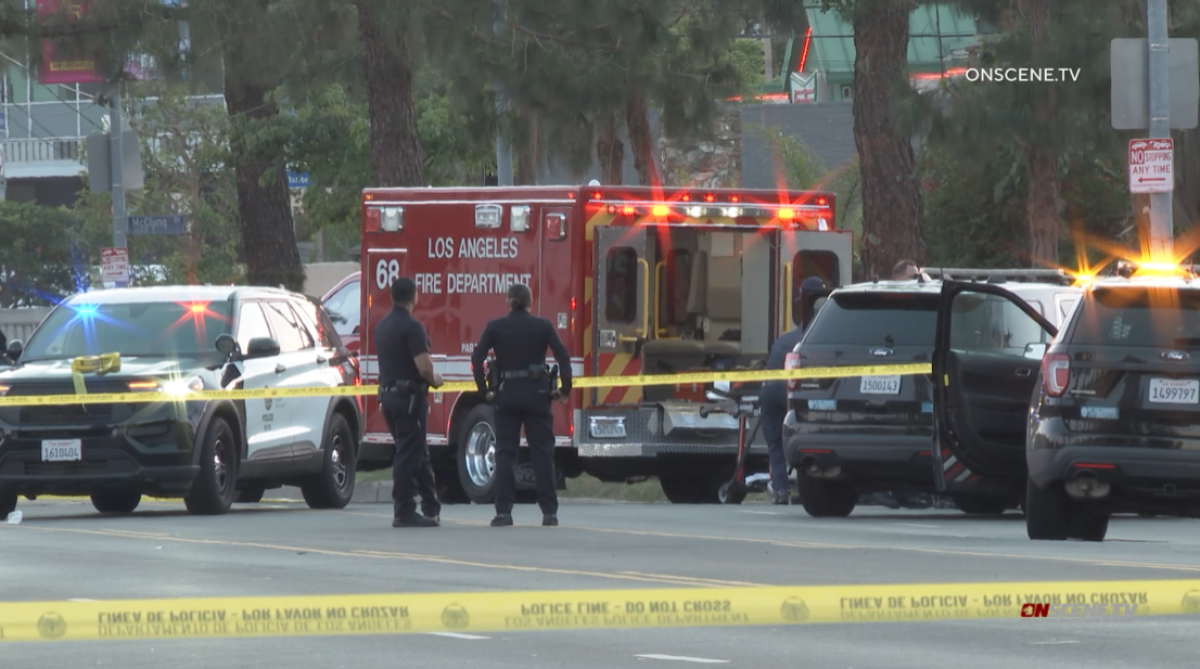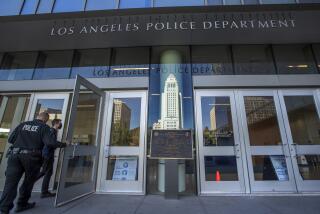LAPD officer faulted in 2022 shooting of unarmed man in Leimert Park

- Share via
A Los Angeles police sergeant broke policy when he shot a mentally ill man from inside his police cruiser last summer in Leimert Park, after mistaking a car part the man was carrying for a gun, the LAPD’s civilian oversight panel ruled this week.
The Board of Police Commissioners agreed with Chief Michel Moore in concluding that even if Sgt. Brett Hayhoe believed the man was armed, he should have gotten out of his vehicle and reassessed the threat before acting.
The victim, Jermaine Petit, who was 39 at the time, was taken to a hospital with serious injuries.
The July 18 shooting occurred after officers, responding to a report of a man with a firearm, confronted Petit as he walked on a sidewalk. Hayhoe, a supervisor in the Southwest Division, was driving along Obama Boulevard when he spotted the encounter.
Body-worn camera footage shows Hayhoe pulling alongside Petit and ordering him to drop his “gun,” then shooting him twice as Petit turns toward him.
The police shooting of Jermaine Petit in July sparked an outcry and questions about why officers opened fire on someone who officials later admitted was unarmed.
Almost simultaneously, another officer, Daryl Glover, fires a single round at Petit from behind him — even though moments before Glover’s partner had blurted out, “It’s not a gun, bro.”
After taking Petit into custody, officers realized the object he was carrying was a black metal latch actuator, part of a car door’s locking mechanism.
On Tuesday, the Board of Police Commissioners voted 3-0 (two members were absent) in favor of Moore’s conclusion that Hayhoe’s use of lethal force violated department policy. Moore’s decision, based on the findings of a months-long internal investigation, cited what he saw as Hayhoe’s poor decision-making. Moore ruled that the sergeant’s actions “escalated the situation and created the exigent circumstance which led to the use of lethal force.”
“Based on the nature of this call, [an internal use-of-force review board] would have preferred that he had not driven alongside Petit,” the chief’s report read. “Rather they would have preferred he had pulled up to the officers and directed them to use his police vehicle as cover while issuing commands to Petit, requesting additional resources and monitoring his direction of travel until the additional resources arrived.”
What punishment Hayhoe receives, if any, falls to Moore; details of disciplinary action in the Police Department rarely become public.
The incident drew criticism from activists and community leaders, who seized on the case as proof that police are unfit to respond to calls involving people in the midst of a crisis; they argue that such emergencies should be handled by unarmed mental health professionals.
Times reporting found that about a third of the more than 30 people shot by LAPD officers in 2021 were believed to have had a mental illness at the time.
Critics also seized on department officials’ insistence for days after the incident that Petit was carrying a “weapon.” Moore’s report acknowledges that Petit was unarmed.
In L.A., mentally ill people are cycled through what police, mental health officials and advocates agree is a revolving door of temporary psychiatric units and jail wards, never getting the long-term care they need.
Relatives have said Petit is a U.S. Air Force veteran who has battled post-traumatic stress disorder and schizophrenia.
After Petit spent years cycling in and out of treatment, his mother tried to get him into a long-term facility, but he refused “to sign over certain rights,” believing that he would be sent to jail if he did, the mother of his daughter previously told The Times.
Instead, he started wandering the streets, sometimes disappearing for weeks. During one stretch several years ago, he was involved in an encounter that ended with LAPD officers shooting him with a stun gun.
The experience left him fearful of police, she recalled.
Under department policy, officers are not supposed to fire from a moving vehicle, except in “exigent circumstances and consistent with the policy regarding the use of deadly force.”
Among the rare exceptions are ambush scenarios. The board pointed out that as a member of the Metropolitan Division’s dignitary protection unit, Hayhoe probably received “anti-ambush training.”
Petit was shot twice — in the jaw and shoulder — and also injured his jaw when he fell to the pavement, according to his lawsuit. No officers were injured.
Petit has sued the city in federal court through a guardian ad litem, arguing that the officers had no cause for detaining him and that he posed no threat. A trial has been set for next year.
Attempts to reach Petit’s attorneys were unsuccessful Friday.
The incident stemmed from a 911 call about a man who appeared homeless and was rummaging through a trash can behind the caller’s house, according to the report prepared by Moore. The man refused to leave and pulled a “pistol,” the caller reportedly said.
As officers responded to that call, another 911 caller said a man of the same description had lit something on fire in the area of 41st Street and Edgehill Drive and was walking around with a stick. That caller reported having seen Petit with a “gun” but could no longer see it.
A short time later, Hayhoe saw Petit walking south on Degnan Boulevard, near the corner of Obama. After conferring briefly with Glover and his partner, Nelson Martinez, the sergeant hung back and watched as the two officers pulled up next to Petit and ordered him to stop.
Martinez jumped out of the passenger seat and ordered Petit to “come here,” according to body camera footage of the encounter posted online.
Petit continued walking away, nervously turning back every few steps while repeating something unintelligible without stopping, the video shows. Martinez continued after Petit with his gun drawn, telling him repeatedly to “take your hands out of your pockets, bro.” Meanwhile, Glover drove ahead and stopped beside Petit, according to the video.
About three seconds later, Hayhoe fired two shots through the open passenger window as his squad car inched along at 2 to 3 miles per hour. Then Glover fired.
A search of Petit’s backpack turned up another actuator and a lighter shaped like a handgun, according to Moore’s report.
Moore concluded, and the commission agreed, that Hayhoe broke department policy. Moore said Hayhoe did not meet the department standards requiring officers to formulate a plan before confronting someone who they assume is armed. While noting that Hayhoe did call for backup, Moore pointed out that the sergeant didn’t wait for other officers to arrive before engaging Petit. The commission agreed.
Moore said he would have preferred that Hayhoe had tried to slow down the encounter by relaying to the two officers the need to employ “high-risk pedestrian stop tactics.”
More to Read
Sign up for Essential California
The most important California stories and recommendations in your inbox every morning.
You may occasionally receive promotional content from the Los Angeles Times.













